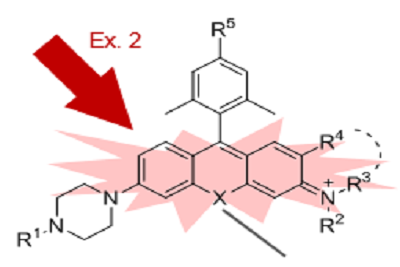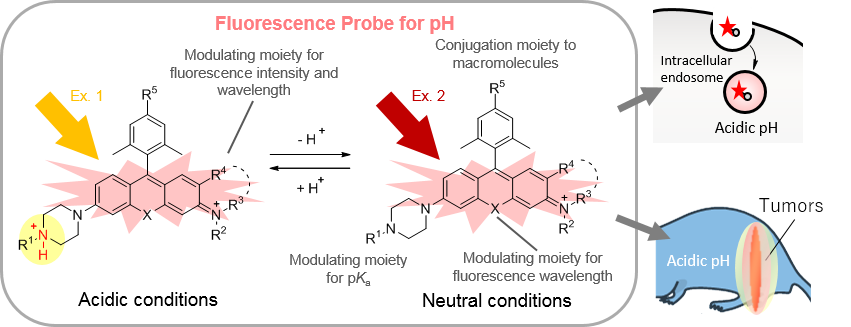Measuring pH in living cells, tissues with novel fluorescent dyes New technique may find applications in disease elucidation, diagnosis


The newly developed fluorescent dyes for pH measurement can be structurally modified to exhibit various colors, pH ranges and conjugation sites.
© 2018 Kenjiro Hanaoka.
University of Tokyo researchers developed a series of novel fluorescent dyes that can measure pH in living samples, from intracellular organelles to tissues inside bodies, by measuring change in fluorescence. The fluorescent dyes are delivered to the target site in living cells or bodies by conjugating them to macromolecules added to the extracellular medium or administered into the vein. Delivery of the fluorescent dyes allows measurement of the pH values around them. Existing fluorescent dyes are unsuitable for measuring pH in acidic organelles and for long-term fluorescence imaging because they are susceptible to photobleaching, an alteration in the dyes that causes them to lose their fluorescence.
In contrast, the fluorescent dyes developed by the research group led by graduate students Shodai Takahashi and Yu Kagami, Associate Professor Kenjiro Hanaoka and Professor Yasuteru Urano at the Graduate School of Pharmaceutical Sciences can perform long-term fluorescence imaging because they are resistant to photobleaching. Moreover, the researchers could prepare custom-made fluorescent dyes suitable for the targeted pH range to measure pH in various living cells and tissues.
This technique for pH measurement is applicable to a wide range of living samples because it does not require genetic technology for the samples. So far, the group has successfully observed pH in intracellular acidic organelles, particularly lysosomes, and the pH change surrounding iron transport proteins when they move from the outside to the inside of the cell. Moreover, the researchers successfully observed pH inside the kidney and tumor of mice in lab experiments by administering the developed fluorescent dyes into veins.
Thus, they could accurately measure pH in tissues and intracellular organelles in real time by using the newly developed fluorescent dyes, and hope that in the future these dyes will contribute to not only diagnosis of tumors, but also shed light on pathology related to pH abnormalities.
"We succeeded in the development of novel fluorescent dyes and luckily found that they show colorimetric change dependent on pH," says Hanaoka. He continues, "Further, we turned them into novel tools for measurement of pH in living samples, a feat never achieved before."
Papers
Shodai Takahashi, Yu Kagami, Kenjiro Hanaoka, Takuya Terai, Toru Komatsu, Tasuku Ueno, Masanobu Uchiyama, Ikuko Honda, Noboru Mizushima, Tomohiko Taguchi, Hiroyuki Arai, Tetsuo Nagano and Yasuteru Urano, "Development of a series of practical fluorescent chemical tools to measure pH values in living samples," Journal of the American Chemical Society J. Am. Chem. Soc. 2018, 140, 5925-5933.: April 24, 2018, doi:10.1021/jacs.8b00277.
Link (Publication )
)
Related links
- Laboratory of Chemistry and Biology, Department of Pharmacy, Graduate School of Pharmaceutical Sciences

- Department of Pharmacy, Graduate School of Pharmaceutical Sciences

- Graduate School of Pharmaceutical Sciences






